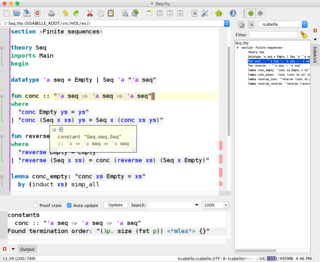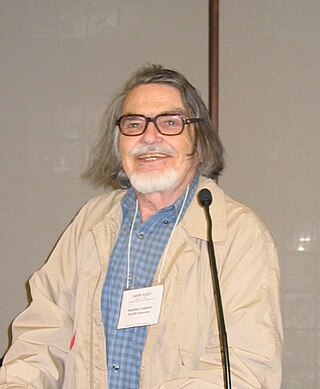Automated theorem proving is a subfield of automated reasoning and mathematical logic dealing with proving mathematical theorems by computer programs. Automated reasoning over mathematical proof was a major impetus for the development of computer science.
In mathematics and theoretical computer science, a type theory is the formal presentation of a specific type system. Type theory is the academic study of type systems.
In logic and proof theory, natural deduction is a kind of proof calculus in which logical reasoning is expressed by inference rules closely related to the "natural" way of reasoning. This contrasts with Hilbert-style systems, which instead use axioms as much as possible to express the logical laws of deductive reasoning.

The Isabelle automated theorem prover is a higher-order logic (HOL) theorem prover, written in Standard ML and Scala. As an LCF-style theorem prover, it is based on a small logical core (kernel) to increase the trustworthiness of proofs without requiring — yet supporting — explicit proof objects.
HOL denotes a family of interactive theorem proving systems using similar (higher-order) logics and implementation strategies. Systems in this family follow the LCF approach as they are implemented as a library which defines an abstract data type of proven theorems such that new objects of this type can only be created using the functions in the library which correspond to inference rules in higher-order logic. As long as these functions are correctly implemented, all theorems proven in the system must be valid. As such, a large system can be built on top of a small trusted kernel.
Proof theory is a major branch of mathematical logic and theoretical computer science within which proofs are treated as formal mathematical objects, facilitating their analysis by mathematical techniques. Proofs are typically presented as inductively-defined data structures such as lists, boxed lists, or trees, which are constructed according to the axioms and rules of inference of a given logical system. Consequently, proof theory is syntactic in nature, in contrast to model theory, which is semantic in nature.
In mathematics and logic, an axiomatic system is any set of primitive notions and axioms to logically derive theorems. A theory is a consistent, relatively-self-contained body of knowledge which usually contains an axiomatic system and all its derived theorems. An axiomatic system that is completely described is a special kind of formal system. A formal theory is an axiomatic system that describes a set of sentences that is closed under logical implication. A formal proof is a complete rendition of a mathematical proof within a formal system.
In programming language theory and proof theory, the Curry–Howard correspondence is the direct relationship between computer programs and mathematical proofs.
A typed lambda calculus is a typed formalism that uses the lambda-symbol to denote anonymous function abstraction. In this context, types are usually objects of a syntactic nature that are assigned to lambda terms; the exact nature of a type depends on the calculus considered. From a certain point of view, typed lambda calculi can be seen as refinements of the untyped lambda calculus, but from another point of view, they can also be considered the more fundamental theory and untyped lambda calculus a special case with only one type.
In mathematics and logic, a higher-order logic is a form of logic that is distinguished from first-order logic by additional quantifiers and, sometimes, stronger semantics. Higher-order logics with their standard semantics are more expressive, but their model-theoretic properties are less well-behaved than those of first-order logic.
Higher order grammar (HOG) is a grammar theory based on higher-order logic. It can be viewed simultaneously as generative-enumerative or model theoretic.
Categorial grammar is a family of formalisms in natural language syntax that share the central assumption that syntactic constituents combine as functions and arguments. Categorial grammar posits a close relationship between the syntax and semantic composition, since it typically treats syntactic categories as corresponding to semantic types. Categorial grammars were developed in the 1930s by Kazimierz Ajdukiewicz and in the 1950s by Yehoshua Bar-Hillel and Joachim Lambek. It saw a surge of interest in the 1970s following the work of Richard Montague, whose Montague grammar assumed a similar view of syntax. It continues to be a major paradigm, particularly within formal semantics.
In logic, a logical framework provides a means to define a logic as a signature in a higher-order type theory in such a way that provability of a formula in the original logic reduces to a type inhabitation problem in the framework type theory. This approach has been used successfully for (interactive) automated theorem proving. The first logical framework was Automath; however, the name of the idea comes from the more widely known Edinburgh Logical Framework, LF. Several more recent proof tools like Isabelle are based on this idea. Unlike a direct embedding, the logical framework approach allows many logics to be embedded in the same type system.
Categorical logic is the branch of mathematics in which tools and concepts from category theory are applied to the study of mathematical logic. It is also notable for its connections to theoretical computer science. In broad terms, categorical logic represents both syntax and semantics by a category, and an interpretation by a functor. The categorical framework provides a rich conceptual background for logical and type-theoretic constructions. The subject has been recognisable in these terms since around 1970.

Joachim "Jim" Lambek was a Canadian mathematician. He was Peter Redpath Emeritus Professor of Pure Mathematics at McGill University, where he earned his PhD degree in 1950 with Hans Zassenhaus as advisor.

In computer science and mathematical logic, a proof assistant or interactive theorem prover is a software tool to assist with the development of formal proofs by human-machine collaboration. This involves some sort of interactive proof editor, or other interface, with which a human can guide the search for proofs, the details of which are stored in, and some steps provided by, a computer.
Twelf is an implementation of the logical framework LF developed by Frank Pfenning and Carsten Schürmann at Carnegie Mellon University. It is used for logic programming and for the formalization of programming language theory.
John Lane Bell is an Anglo-Canadian philosopher, mathematician and logician. He is Professor Emeritus of Philosophy at the University of Western Ontario in Canada. His research includes such topics as set theory, model theory, lattice theory, modal logic, quantum logic, constructive mathematics, type theory, topos theory, infinitesimal analysis, spacetime theory, and the philosophy of mathematics. He is the author of more than 70 articles and of 13 books. In 2009, he was elected a Fellow of the Royal Society of Canada.
Q0 is Peter Andrews' formulation of the simply-typed lambda calculus, and provides a foundation for mathematics comparable to first-order logic plus set theory. It is a form of higher-order logic and closely related to the logics of the HOL theorem prover family.















